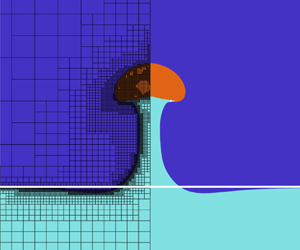No CrossRef data available.
Article contents
Bubble-induced entrainment at viscoplastic–Newtonian interfaces
Published online by Cambridge University Press: 20 May 2024
Abstract

The passage of single air bubbles through the horizontal interface between viscoplastic and Newtonian fluids, considering various combinations of densities and viscosities for the fluid layers, is studied computationally. The primary focus is on the quantity of liquid transferred from the lower layer (viscoplastic fluid) to the upper layer (Newtonian fluid) as a result of the bubble's ascent, a factor with significant implications for the turbidity of methane-emitting lakes and water bodies. The entrainment characteristics are observed to vary considerably with the bubble shape, within the lower layer and as the bubble approaches the interface. The results show that at Bond number  $(Bo)>1$ and moderate Archimedes (
$(Bo)>1$ and moderate Archimedes ( $Ar$), prolate-shaped bubbles crossing the interface undergo elongation in the direction of their poles. This elongation is further accentuated when the viscosity of upper layer is less than the plastic viscosity of the lower layer. The bubble is found to break up when leaving the lower layer, of a critical capillary number,
$Ar$), prolate-shaped bubbles crossing the interface undergo elongation in the direction of their poles. This elongation is further accentuated when the viscosity of upper layer is less than the plastic viscosity of the lower layer. The bubble is found to break up when leaving the lower layer, of a critical capillary number,  $Ca_c \approx 5$. The results show a significant reduction in the volume of entrainment compared with the Newtonian counterpart. This suggests disturbances caused by the rising bubble at the interface dissipate over a smaller region. Four distinct entrainment regimes are identified, mainly indicating the height to which the entrained fluid can be transported away from the interface. In contrast to Newtonian fluids, the volume of entrainment increases by decreasing the viscosity of the upper layer. Interestingly, the heavy viscoplastic fluid that has been dragged up into the light Newtonian fluid does not recede with time.
$Ca_c \approx 5$. The results show a significant reduction in the volume of entrainment compared with the Newtonian counterpart. This suggests disturbances caused by the rising bubble at the interface dissipate over a smaller region. Four distinct entrainment regimes are identified, mainly indicating the height to which the entrained fluid can be transported away from the interface. In contrast to Newtonian fluids, the volume of entrainment increases by decreasing the viscosity of the upper layer. Interestingly, the heavy viscoplastic fluid that has been dragged up into the light Newtonian fluid does not recede with time.
JFM classification
- Type
- JFM Papers
- Information
- Copyright
- © The Author(s), 2024. Published by Cambridge University Press





